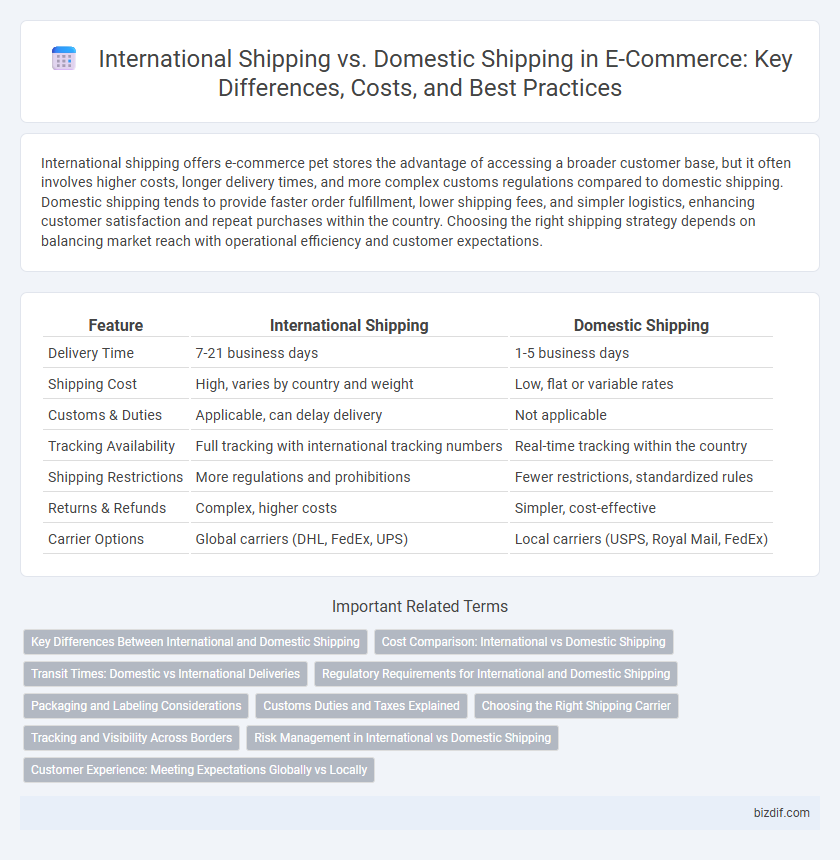International shipping offers e-commerce pet stores the advantage of accessing a broader customer base, but it often involves higher costs, longer delivery times, and more complex customs regulations compared to domestic shipping. Domestic shipping tends to provide faster order fulfillment, lower shipping fees, and simpler logistics, enhancing customer satisfaction and repeat purchases within the country. Choosing the right shipping strategy depends on balancing market reach with operational efficiency and customer expectations.
Table of Comparison
| Feature | International Shipping | Domestic Shipping |
|---|---|---|
| Delivery Time | 7-21 business days | 1-5 business days |
| Shipping Cost | High, varies by country and weight | Low, flat or variable rates |
| Customs & Duties | Applicable, can delay delivery | Not applicable |
| Tracking Availability | Full tracking with international tracking numbers | Real-time tracking within the country |
| Shipping Restrictions | More regulations and prohibitions | Fewer restrictions, standardized rules |
| Returns & Refunds | Complex, higher costs | Simpler, cost-effective |
| Carrier Options | Global carriers (DHL, FedEx, UPS) | Local carriers (USPS, Royal Mail, FedEx) |
Key Differences Between International and Domestic Shipping
International shipping involves longer transit times, complex customs regulations, and higher costs compared to domestic shipping, which typically offers faster delivery and simpler logistics within a single country. International shipments require detailed documentation such as customs declarations and may incur duties and taxes, whereas domestic shipping usually avoids these barriers. Tracking and insurance options also differ, with international shipping demanding more comprehensive solutions to mitigate risks during extended transport across multiple jurisdictions.
Cost Comparison: International vs Domestic Shipping
International shipping costs often exceed domestic shipping expenses due to higher tariffs, customs fees, and longer transit distances, which increase carrier charges and handling fees. Domestic shipping benefits from streamlined logistics, lower fuel costs, and reduced regulatory complexities, resulting in more affordable rates and faster delivery times. Businesses must analyze package weight, destination zones, and carrier services to optimize shipping costs between international and domestic markets.
Transit Times: Domestic vs International Deliveries
Domestic shipping typically offers shorter transit times, ranging from 1 to 5 business days depending on the courier and service level. International shipping transit times vary widely, often spanning 7 to 21 days or more due to customs clearance, distance, and international logistics complexities. E-commerce businesses must balance customer expectations with shipping costs by choosing appropriate carriers and shipping options that optimize delivery speed and reliability.
Regulatory Requirements for International and Domestic Shipping
International shipping requires compliance with complex customs regulations, import/export restrictions, and documentation such as commercial invoices, certificates of origin, and harmonized tariff codes. Domestic shipping primarily focuses on adherence to national transportation laws, safety standards, and local postal regulations, which are generally less stringent than international rules. Failure to meet international regulatory requirements can result in delayed shipments, fines, or confiscation, emphasizing the critical need for thorough knowledge of global trade compliance.
Packaging and Labeling Considerations
Packaging for international shipping requires compliance with diverse regulations, including durable materials to withstand longer transit and customs inspections, while domestic shipping often allows for lighter, more cost-effective packaging. International labels must include detailed customs documentation, harmonized system codes, and clear country-of-origin markings, whereas domestic labels primarily focus on standard delivery information. Ensuring correct and compliant packaging and labeling reduces delays, minimizes damage risk, and enhances customer satisfaction across both shipping methods.
Customs Duties and Taxes Explained
Customs duties and taxes significantly impact international shipping costs, as products must clear customs and comply with destination country regulations, often resulting in added fees. Domestic shipping bypasses these complexities, allowing for faster delivery and predictable costs without extra customs charges. Understanding the tariff classifications, harmonized system codes, and import taxes is essential for e-commerce businesses to price products accurately and avoid unexpected expenses during cross-border transactions.
Choosing the Right Shipping Carrier
Selecting the right shipping carrier is crucial for optimizing costs and delivery times in both international and domestic e-commerce. Key factors include carrier reliability, tracking capabilities, customs clearance efficiency for international shipments, and competitive pricing structures tailored to order volume and destination. Leveraging carriers with robust networks and specialized services ensures customer satisfaction and scalable logistics operations.
Tracking and Visibility Across Borders
International shipping often faces challenges in tracking and visibility due to multiple carriers, customs checks, and cross-border regulations, which can lead to delays in real-time updates. Domestic shipping typically offers more reliable and accurate tracking information with streamlined logistics and fewer regulatory hurdles, ensuring better shipment visibility for both sellers and customers. Advanced tracking technologies and integrated shipping platforms are increasingly bridging the gap, enhancing transparency and customer experience in international e-commerce deliveries.
Risk Management in International vs Domestic Shipping
International shipping carries higher risk due to complex customs regulations, longer transit times, and increased potential for cargo damage or loss compared to domestic shipping. Effective risk management in international shipping involves comprehensive insurance coverage, real-time tracking technologies, and robust compliance with global trade regulations to mitigate delays and financial losses. Domestic shipping benefits from streamlined logistics and fewer regulatory hurdles, resulting in lower risk and often reduced need for extensive risk mitigation strategies.
Customer Experience: Meeting Expectations Globally vs Locally
International shipping challenges e-commerce businesses to meet diverse customer expectations regarding delivery speed, customs clearance, and shipping costs, which can impact satisfaction and repeat purchases. Domestic shipping often provides faster delivery, more reliable tracking, and lower shipping fees, enhancing the local customer experience and encouraging brand loyalty. Optimizing logistics and communication for each shipping type is crucial for maintaining consistent service quality and meeting customer expectations across global and local markets.
International Shipping vs Domestic Shipping Infographic

 bizdif.com
bizdif.com